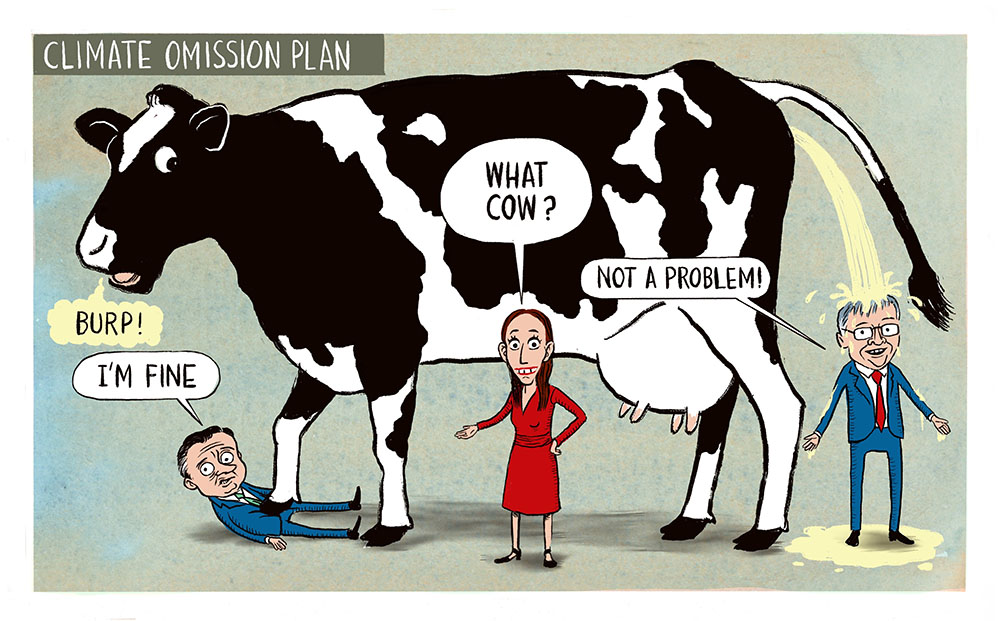The last 6 months have taken us from beauty, to tragedy, to reflection and action.
Looking back at the start of 2023 it seems a long time ago! I remember the beautiful sunshine of the South Island as I had the chance to travel to visit many of my favourite spots. I talked with friends, farmers, tourists and others about the challenges facing our local ecosystems, and the places we’re inspired to protect.
Then the climate crisis hit home. In a way, we’ve become sadly used to international news of wildfires, breaking temperatures, melting ice caps, warming oceans and forest destruction. This year we had our own wake up call that New Zealand is not isolated from climate breakdown. Communities across the North Island dealt with extreme flooding on a scale we haven’t planned for.
In response, our Greenpeace crew wanted to turn attention back to the cause of the climate crisis – the polluters.
So we took the effects and detritus of the storms – people’s damaged household goods- to the doors of the head office of New Zealand’s top climate polluter. That’s the dairy giant Fonterra. My friend Guy was with us to share his story, as his property in West Auckland had been flooded three times in 18 months.
Why Fonterra? The dairy corporate is New Zealand’s single biggest climate polluter and needs to urgently reduce the methane emissions it’s responsible for.
We went to Tairāwhiti to share the story of Tui (Greenpeace board chair), Maria and Bobbie – three wāhine Māori who have had to deal with the compounding impacts of extreme weather events and damaging use of land from farming and forestry.
The stories are tragic. But I have also met many passionate people along the way. The reality of climate change is turning everyone into activists. On each of the climate strikes this year I’ve been inspired by the coming together of people of all ages focused on the solutions. The national Climate Strike organisers are setting simple and clear demands for action.
Our Greenpeace crew have been vocal across social media platforms and outspoken in the media. I’m invited almost every week to speak to journalists on climate issues.
On the Parliamentary side, we made a range of submissions on various Government consultations – we recommended a stronger Emissions Trading Scheme (ETS), and an Emissions Reduction Plan (ERP – yes there are so many acronyms!) that doesn’t give industrial dairy polluters a free ride as it does at the moment.
We also urged that all advice by the Climate Change Commission should be binding and free from political interference, so the ETS operates as it should, and includes the country’s worst climate polluters. Other sectors are part of the ETS, yet the agriculture sector is blocking all endeavours to be a responsible climate citizen. The Government is even considering giving Fonterra yet more free pollution credits – Fonterra have found it’s far cheaper to invest in lobbying than real emissions reductions.

We then saw the National Party’s announcement they would again delay the entry of agriculture into emissions pricing as yet more of the same, and wilfully ignoring climate science.
In April I was back in the South Island to talk with people about nitrate levels in their drinking water. Over 200 people in Ashburton, Gore and Lumsden tested their water at our walk-in events. We found concerning nitrate contamination due to the use of synthetic nitrogen fertiliser.
We know that behind the scenes, the Government is about to review the fertiliser cap which (after much pressure from environmental groups and communities) set a limit on the use of synthetic nitrogen fertiliser in 2021. While we were successful at that time, the limit is too high, which allows the intensive dairy industry to pollute freshwater, rural drinking water and the climate with too much synthetic nitrogen fertiliser and too many cows.
In May as part of Organics week Niamh (our Programme director) and I had a great discussion with Pere Huriwai-Seger (Aotearoa Liberation League), and Shane Ward (agroecologist and regenerative land use advisor) about the outsized impacts of big dairy on the environment, and New Zealand’s role in turning around the climate and biodiversity crises. We discussed why we’re hopeful for the future of food, and what we can all do to help bring about the transformation of the food system.
We’ve also been having direct conversations with the people working to build the soil and produce food. We talked with inspiring people who are working across a spectrum of ecological farming to find out more about them and ask what they think a sustainable food system would look like.
I imagine this year you’ve had your own conversations around climate, and I would love to hear what you find. You may have discovered what a recent poll has shown – that most people don’t know what to do about climate change, even when realising what a crucial time this is to guarantee a safe future for the tamariki of today.
While there are always individual actions we can take, acting collectively for social and political change is how we change our systems. It’s not easy, but we can build collective power by inviting those around us to act and speak out for the health of Papatūānuku.
One way Greenpeace is doing this is by joining with Oxfam and Forest & Bird and more than 40 other groups. Last month we launched a call for a climate focused election, the Climate Shift. Over 11,000 people have already signed on to our 10 point plan that demands from all political parties, real emissions reductions, restoring and rewilding nature, and support for communities on the frontline of the climate crisis.
I hope you find strength this Matariki as we reflect back on how we stood up and spoke out together, while acknowledging the demands of the moment, and working for a better future.
